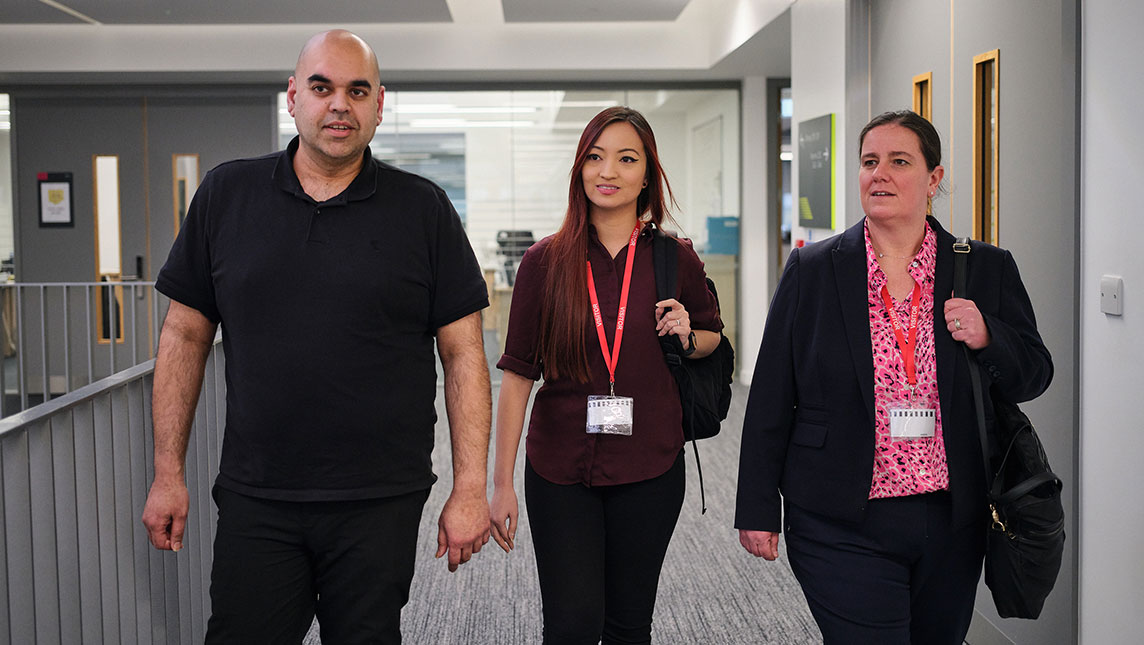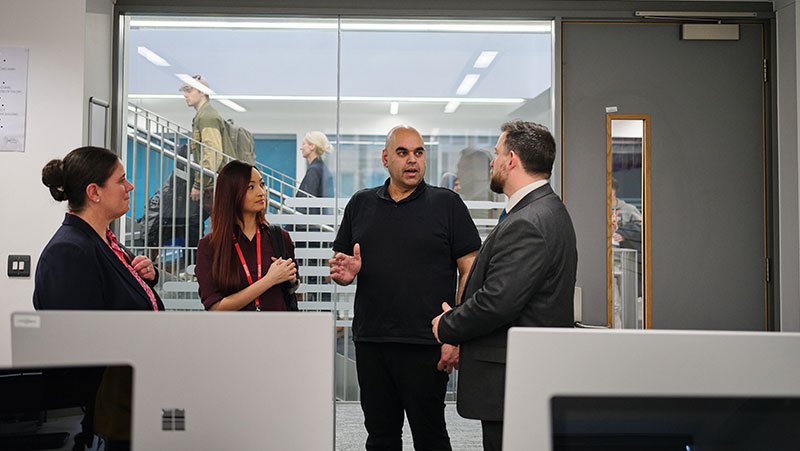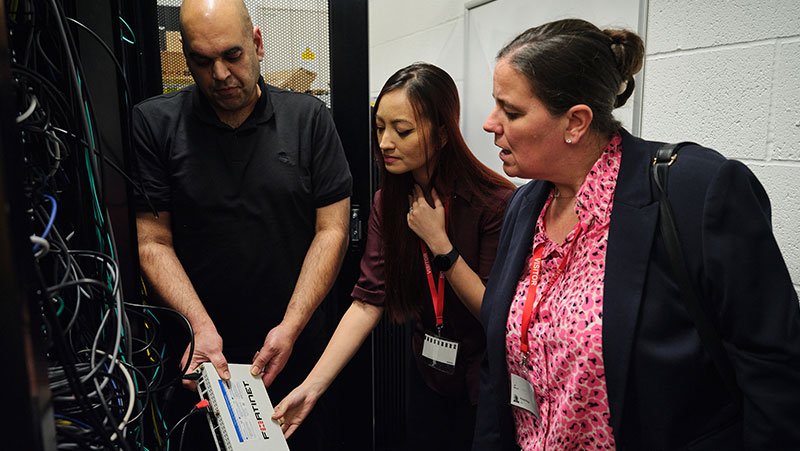
A RAAC race against time: connecting a sixth form at speed
Imagine finding out, just days before your sixth form students are due to start their courses in September, that the school building is unsafe for use and there is nowhere for them to learn…
That’s the situation Aston Manor Academy found itself in when the RAAC emergency hit the news in late summer 2023, struck by the ‘crumbling concrete’ crisis that closed down more than 150 schools across the country. The race was on to rehome its 260-strong sixth form in a safe space in time for the new academic year.
Dan Preston, assistant head teacher sixth form at the school, takes up the story:
“We found out about the issues with the RAAC in the roof just days before we were due to start back at school. We were all very shocked – and confused about what would happen next. Would students return to school? How long would it take? We didn't want any lost learning, especially considering that our students had already been through Covid times.”
Luckily, just round the corner was Aston University Engineering Academy (AUEA), a STEM centre of excellence for 13- to 19-year-olds, which happened to have an almost empty building, in pre-opening phase for the new Aston University Mathematics School. Even though part of the building was allocated for T-Level students with engineering workshops and a hospital simulation for training midwives, only a small number of AUEA students were due to occupy it to begin with.
AUEA executive principal Daniel Locke-Wheaton offered it to Aston Manor Academy without hesitation:
“It was a no brainer. Morally, it was the right thing to do.”
However, while the building itself was ready and waiting, the internet wasn’t. The space had previously been used by an FE college, the National College for High-Speed Rail, and AUEA had made the fair assumption that essential services, such as connectivity, would flow over to its new users. Daniel Locke-Wheaton explains:
“In an ideal world, there would've been a seamless transfer of connectivity and all the systems from one provider to the next. What actually happened was the complete opposite. Not only did we lose connectivity through the termination of supply, we also lost all internal infrastructure. We lost all servers and all wireless as well. So in the space of a week and a half, the building had gone from state of the art to the dark ages."
Watch the story
Hear Dan, Daniel, Jen, Anne and Wasif tell their story of getting students back in the classroom and learning by using Jisc's innovative SD-WAN concept.
A worrying time for everyone involved
Aston Manor Academy students needed to be in the space and learning within a matter of days. But, without an internet connection, what kind of learning could take place? Many of the learners were studying vocational courses that required constant connectivity.
Dan Preston says:
“Staff were very concerned with the move. Although it was a wonderful building and a lovely environment for our students, would they be able to teach as they wanted to? Would just students be affected by not having the use of the internet?”
There were, of course, connectivity workarounds and temporary solutions, which is what AUEA IT manager Wasif Khan had planned to rely on when he was only planning to accommodate AUEA’s initial cohort of students:
“We were looking at a building-to-building wireless bridge to use the existing services at our main building for those couple of dozen students and handful of staff initially. But, obviously, with having to accommodate a lot more students and staff, it became a case of needing something more permanent, more reliable.”
And they needed it fast. Which is when the Department for Education (DfE) picked up the phone to Jisc, who jumped into action.

Piloting new technology
Establishing a Janet link would have been time consuming and involved technical challenges, especially around filtering content. Fortunately, Jisc had been working on a more lightweight solution using SD-WAN technology, which involves a firewall device that is managed centrally to enable filtering to meet safeguarding requirements – making it ideal for schools – and, crucially, speed of setup.
Whereas a Janet connection has a lead time of about five months from point of order, because it requires coordination with external suppliers, an SD-WAN connection can be in place within a couple of weeks.
As an immediate stopgap, Jisc sent a device to provide 4/5G connectivity, followed by a Fortinet device that would enable web filtering, all while the fixed line SD-WAN solution was being organised. The web filtering was being done by a virtual machine on an AWS Outpost in the heart of Janet, which served as a valuable asset to providing these critical functions in the early stages.

Once the building had transitioned to the full connection, the 4/5G solution was retained as a back up. For Jisc’s Jen Parry and Anne Prior, it was an invaluable opportunity to pilot this new Jisc technology. Jen elaborates:
“In my team at Jisc we're innovation consultants and we take technology that’s well established in industry and integrate it with Jisc technology from products such as Janet so that we can find value for those technologies in the education sector. Janet is a private network, so it's fast, low latency and very secure.
"One of the benefits of a managed SD-WAN solution is that we can take the secure aspect of the Janet Network and offer it beyond the private lines that are currently being used for the Janet.”
While managed SD-WAN was still in development stage, for Wasif Khan in no sense did it feel that it was being trialled. He also valued the process of working with Jisc, especially the communication with the team. There was no downtime during operational hours and the team would always check before installing any firmware updates, to ensure it was convenient.
“Working with the technical team at Jisc wasn't stressful, even in a stressful situation. If something didn't work, we would work together on how to resolve it, rather than being told ‘oh, that's somebody else's problem’. In my experience of IT partners, that's quite unique.”
And the result? In terms of making the best out of a crisis, it couldn’t have gone better. In the words of Dan Preston:
“I'm delighted to say that within ten days, on Monday 18 September, we all moved up, the sixth form and staff were over and at 9am we had 260 students actively engaging their learning, which is quite incredible to think about.
"Our students have just flourished. They do not want to leave the building. They absolutely love it. And with more of a university feel within the building, it's standing them in good stead for the future, especially for those students that are going to go off to university in September.”
For Jisc, it’s also been a valuable learning experience, Anne Prior, Jisc’s head of independent education and schools concludes:
“For us, it's served as a really good solution that we can deploy quickly. This project has been very much about what Jisc does to help support the sector, always looking at new technology and how it can be used to help support the needs within the education sector. With Jisc and our customers, it's about that whole experience, having the right expertise and knowledge at the right time, and always having someone on hand to help and support them."
Find out more
- Discover our connectivity services
- Sign up to Headlines - our newsletter which has all the latest edtech news, guidance and events tailored to you